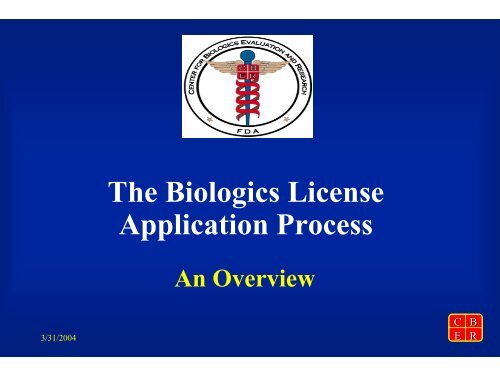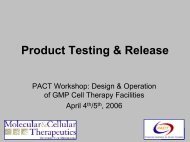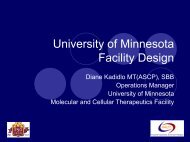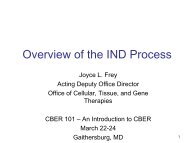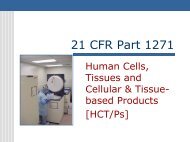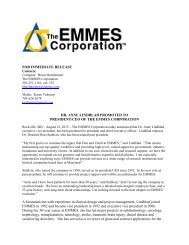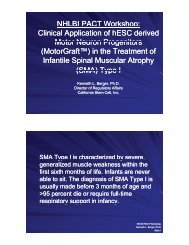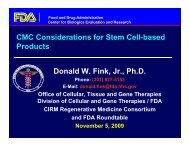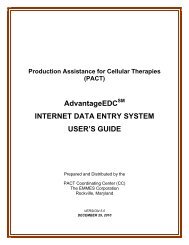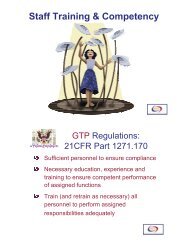CBER 101 - Biologics License Application Process
CBER 101 - Biologics License Application Process
CBER 101 - Biologics License Application Process
Create successful ePaper yourself
Turn your PDF publications into a flip-book with our unique Google optimized e-Paper software.
The <strong>Biologics</strong> <strong>License</strong><br />
<strong>Application</strong> <strong>Process</strong><br />
An Overview<br />
3/31/2004<br />
C<br />
E<br />
B<br />
R
Preface<br />
• This presentation walks through the review process<br />
for a BLA.<br />
• <strong>CBER</strong> reviews and approves/clears medical devices<br />
(510(k) and PMA) as well as new drugs (NDA and<br />
ANDAs)<br />
• Please bear in mind that the principles presented<br />
here are generally applied to these other regulatory<br />
pathways (with adjustments to accommodate their<br />
specific regulatory requirements/recommendations)<br />
• For example….<br />
C<br />
E<br />
B<br />
R
Drug development phases:<br />
Discovery Investigational Marketing<br />
<strong>Application</strong><br />
Post<br />
marketing<br />
Review submission types:<br />
Pre-IND,<br />
-IDE<br />
IND, IDE<br />
BLA, 510(k),<br />
PMA, NDA,<br />
ANDA<br />
Post<br />
marketing<br />
C<br />
E<br />
B<br />
R
What is a <strong>Biologics</strong> <strong>License</strong><br />
<strong>Application</strong> (BLA)?<br />
A request for permission to introduce, or deliver<br />
for introduction, a biologic product into<br />
interstate commerce<br />
21 CFR 601.2<br />
C<br />
E<br />
B<br />
R
<strong>CBER</strong> Regulatory Authority<br />
• BIOLOGICS<br />
– Investigational New Drug Exemptions (IND, 21 CFR 312)<br />
– <strong>Biologics</strong> <strong>License</strong> <strong>Application</strong>s (BLA, 21 CFR 600-680)<br />
• EXAMPLES<br />
– Vaccines and allergenic products<br />
– Blood Products (including blood grouping reagents and<br />
donor screening tests for bloodborne pathogens)<br />
– Cellular & gene therapies, xenotransplantation)<br />
C<br />
E<br />
B<br />
R
Who Submits a BLA ?<br />
MANUFACTURER (Applicant)<br />
• Any legal person or entity who is engaged in<br />
manufacture<br />
or<br />
• An applicant for a license who takes responsibility<br />
for compliance with product and establishment<br />
standards<br />
C<br />
E<br />
B<br />
R
What is in a BLA?<br />
• Form FDA 356h (cover sheet)<br />
• Applicant Information<br />
• Product / Manufacturing information<br />
• Pre-clinical studies<br />
• Clinical studies<br />
• Labeling<br />
C<br />
E<br />
B<br />
R
BLA – Applicant Information<br />
•Name, address & phone number<br />
•Name & address of facilities<br />
•Authorized official<br />
C<br />
E<br />
B<br />
R
BLA – Product/Manufacturing<br />
Information<br />
• Source material / raw materials<br />
• Manufacturing process and controls<br />
• Formulation<br />
• Facility information<br />
• Contamination/cross-contamination information<br />
• Environmental assessment or categorical exclusion<br />
C<br />
E<br />
B<br />
R
BLA – Safety, Efficacy and Use<br />
Information<br />
•Pre-clinical studies<br />
•Clinical studies<br />
•Labeling<br />
C<br />
E<br />
B<br />
R
International Harmonization<br />
Using the CTD (Common Technical Document)<br />
• An agreed upon common format for the modular<br />
presentation of summaries, reports and data<br />
• Content is harmonized to the extent of relevant<br />
ICH guidelines<br />
• Guidance for Industry:<br />
Submitting Marketing <strong>Application</strong>s According to<br />
the ICH-CTD Format - General Considerations<br />
– http://www.fda.gov/cber/gdlns/mrktapich.pdf<br />
C<br />
E<br />
B<br />
R
Electronic Submissions<br />
• Submission of BLA/S may be made on paper or<br />
electronically<br />
• Submissions should be made in accordance with<br />
published guidance:<br />
– http://www.fda.gov/cber/esub/esub.htm<br />
C<br />
E<br />
B<br />
R
• MRP<br />
Managed Review <strong>Process</strong><br />
– Developed to meet PDUFA requirements<br />
– Standardized the review process<br />
– Helps standardize review content (scientific review)<br />
• Not all review content can be standardized<br />
– Product variation<br />
– Manufacturing process variation<br />
– Complexity of biologics<br />
• Some review content can be standardized<br />
– Where the knowledge base is sufficient for<br />
– products<br />
– processes<br />
C<br />
E<br />
B<br />
R
Managed Review <strong>Process</strong><br />
• Milestones in the review process are “positive” or<br />
“negative” actions, e.g.,<br />
– IND/IDE hold/disapproval (Negative)<br />
– BLA, PMA, etc., Refuse to File (Negative)<br />
– Issue an approval (Positive)<br />
• These decisions are based on review of the<br />
submission by the review team<br />
C<br />
E<br />
B<br />
R
The Review Committee<br />
CONSTITUTED TO CONTAIN THE<br />
NECESSARY EXPERTISE TO<br />
REVIEW THE SUBMISSION<br />
C<br />
E<br />
B<br />
R
Responsibilities –<br />
Chairperson/Lead<br />
• CONSTITUTE the committee<br />
• ASSIGN sections for review<br />
• SCHEDULE and CONDUCT meetings w/RPM<br />
• REVIEW according to Managed Review and Good Review<br />
Management Principles<br />
• WRITE “action” letters w/RPM<br />
• PRESENT at Advisory Committee Meetings<br />
• REQUEST a pre-license inspection<br />
• PREPARE a Summary of Basis for Approval (SBA)<br />
C<br />
E<br />
B<br />
R
Responsibilities<br />
Regulatory Project Manager<br />
• MANAGE the review of the application<br />
• REVIEW assigned portions of application<br />
• PERFORM QC check on the review process<br />
• ASSURE reviews are documented properly<br />
• ASSURE review of labeling is complete<br />
• COORDINATE compliance status check<br />
• PREPARE approval letter for new products<br />
• PREPARE finding of no significant impact<br />
C<br />
E<br />
B<br />
R
Responsibilities<br />
Discipline Reviewer<br />
• REVIEW assigned sections of the application<br />
• WRITE a review memo, containing a summary,<br />
recommendation for action and letter-ready questions<br />
• ATTEND and PARTICIPATE in review committee<br />
meetings following Good Review Management Principles<br />
and Managed Review Procedures<br />
• COMMUNICATE with the applicant and document the<br />
discussion (as per Staff Manual Guide 2126.2)<br />
• PREPARE for Advisory Committee meetings<br />
• PARTICIPATE in the pre-approval inspection (if<br />
necessary)<br />
• CONSIDER if a public health and/or research questions<br />
need to be answered relative to product approval<br />
C<br />
E<br />
B<br />
R
Before the BLA is Submitted<br />
• Pre-BLA meeting<br />
– <strong>CBER</strong> SOPP 8<strong>101</strong>.1 Scheduling and Conduct of Regulatory<br />
Review Meetings with Sponsors and Applicants<br />
• Identify potential review committee<br />
• Consider Advisory Committee needs & schedule<br />
• Arrange for BiMo Inspection<br />
C<br />
E<br />
B<br />
R
<strong>Application</strong> Received<br />
• Administrative processing<br />
– Submission tracking number assigned (STN)<br />
– data entry<br />
– user fee verification<br />
• First committee meeting<br />
– review assignments<br />
– time frames<br />
C<br />
E<br />
B<br />
R
SUBMISSION TRACKING NUMBER<br />
aaaaaa.bbbb/cccc<br />
C<br />
E<br />
B<br />
R
Filing Review<br />
• Review for completeness<br />
– RTF policy<br />
– <strong>CBER</strong> SOPP 8404 Refusal to File Guidance for Product<br />
<strong>License</strong> <strong>Application</strong>s and Establishment <strong>License</strong><br />
<strong>Application</strong>s<br />
• Filing meeting<br />
• Filing letter<br />
• Communicate any significant deficiencies noted up<br />
to that time (but not a complete review) by day 74<br />
C<br />
E<br />
B<br />
R
Refuse To File<br />
• A refusal to file (RTF) letter is issued when the<br />
submission has been deemed not sufficiently<br />
complete for a meaningful review<br />
• 21 CFR601.2(a), RTF Policy, SOPP 8404<br />
• The Applicant may request that the submission be<br />
Filed Over Protest: SOPP 8404.1<br />
C<br />
E<br />
B<br />
R
<strong>CBER</strong> Management Oversight: QA<br />
• Refuse to File Oversight Committee<br />
– Composed of representatives from<br />
• <strong>CBER</strong> Management (Review Management, Policy, QA, Deputy Director for<br />
Medicine, Center Director)<br />
• Product Offices (OBRR, OVRR, OTRR, OCBQ)<br />
• Center for Drugs (Office of Medical Products)<br />
– Review team presents a summary highlighting the reason<br />
for the refusal to file<br />
– The Applicant is invited to present their point of view<br />
– Evaluates the quality of the review process<br />
C<br />
E<br />
B<br />
R
Complete Review<br />
• Substantive review<br />
– Information requests<br />
– Discipline reviews<br />
– Review memos<br />
– Labeling<br />
– Lot release protocols<br />
• Inspections<br />
– Facility<br />
– Bioresearch Monitoring<br />
• Advisory Committee presentation, as appropriate<br />
C<br />
E<br />
B<br />
R
Information Requests (IRs)<br />
• Issued while the review is in progress<br />
• Requests information needed to continue the review<br />
• IRs may be made by letter, telephone or FAX<br />
• IRs are documented in the file<br />
• The response to an information request should not be so<br />
great as to constitute a major amendment<br />
• Responses to information requests do not necessarily have<br />
to be reviewed in the current review cycle<br />
• DOES NOT STOP THE REVIEW CLOCK<br />
• SOPP 8401.1<br />
C<br />
E<br />
B<br />
R
Discipline Reviews (DRs)<br />
• A DR letter is issued when a particular discipline<br />
(clinical, CMC, etc.) has finished its review, but the<br />
complete review is not yet done<br />
• A DR letter contains comments and questions that<br />
might appear in the action letter<br />
• Responses to DR letters need not necessarily be<br />
reviewed prior to issuance of the action letter<br />
• DOES NOT STOP THE REVIEW CLOCK<br />
• SOPP 8401.1<br />
C<br />
E<br />
B<br />
R
Administrative Record<br />
•Paper trail documenting the decision making<br />
process and basis for the decision<br />
•Copies of Telecons, FAXes, Review Memos,<br />
Meeting Minutes, etc., become part of the<br />
administrative record and are entered into the<br />
file and the tracking system<br />
C<br />
E<br />
B<br />
R
Action Decision<br />
• After a complete review is finished<br />
– Inspections<br />
– Advisory Committee<br />
• Review Committee meeting<br />
– Outstanding issues<br />
– Agreements & commitments<br />
• <strong>License</strong> action recommendation<br />
– Not ready for approval<br />
– Approval<br />
C<br />
E<br />
B<br />
R
ACTION<br />
Not Ready for Approval<br />
• COMPLETE RESPONSE LETTER<br />
– Itemizes all deficiencies in the application that must be<br />
corrected prior to approval<br />
– Stops the review clock<br />
• RESUBMISSION<br />
– Class 1 or 2<br />
– Restarts the clock<br />
C<br />
E<br />
B<br />
R
PDUFA Resubmissions<br />
• Guidance for Industry: Classifying Resubmissions<br />
in Response to Action Letters, May 14, 1998<br />
• SOPP 8405.1 Procedures for the Classification of<br />
Resubmissions of an <strong>Application</strong> for a Product<br />
Covered by PDUFA III<br />
C<br />
E<br />
B<br />
R
Performance Goals (con’t)<br />
Resubmitted <strong>Application</strong>s (Efficacy Supplements)<br />
• Class 1<br />
– 90% in 2 months (90% in 4 mo.; 50 % in 2 mo.)<br />
• Class 2<br />
– 90% in 6 months (90% in 6 mo.)<br />
• Clinical Hold Responses<br />
– 90% in 30 days<br />
• Major Dispute Resolution<br />
– 90% in 30 days<br />
• Special Protocol Assessments<br />
– 90% in 45 days<br />
C<br />
E<br />
B<br />
R
Dispute Resolution<br />
• Guidance for Industry: Formal Dispute Resolution:<br />
Appeals Above the Division Level<br />
• SOPP 8005 Major Dispute Resolution <strong>Process</strong><br />
(2/11/99)<br />
C<br />
E<br />
B<br />
R
ACTION<br />
Approval<br />
• Compliance check<br />
• Summary of Basis for Approval (SBA)<br />
• Finding of No Significant Impact (FONSI) or<br />
confirm categorical exclusion<br />
• Approval letter<br />
– Grants permission to distribute<br />
– Itemizes all agreements & commitments<br />
• Issue license<br />
C<br />
E<br />
B<br />
R
•SGRA<br />
Rules of the Road for<br />
Reviewers<br />
–SOPPs<br />
–Guidances<br />
–Regulations<br />
–Acts<br />
C<br />
E<br />
B<br />
R
Good Review Management<br />
Principles<br />
Addendum<br />
C<br />
E<br />
B<br />
R
Good Review Management<br />
Principles<br />
• Guidance issued under PUDFA III<br />
• To promote improving review performance in the<br />
first cycle by focusing on<br />
– FDA activities<br />
– Sponsor activities<br />
– Communications<br />
– At each stage of the review....<br />
C<br />
E<br />
B<br />
R
Good Review Management<br />
Principles<br />
• Presubmission<br />
• <strong>Application</strong> Receipt <strong>Process</strong>ing (Prefiling)<br />
• Filing<br />
• Review Planning<br />
• Review<br />
• Advisory Committee Meetings<br />
• Wrap Up and Labeling<br />
• Action<br />
• Cycles of Review<br />
C<br />
E<br />
B<br />
R
Good Review Management<br />
Principles<br />
• Overall Principles - FDA Focus<br />
– Ensure a well managed review<br />
A. A strong interdependence among the primary FDA review team,<br />
B. frequent interactions between the primary review team and supervisory<br />
reviewers, and<br />
C. and project management is critical in the successful completion of the<br />
first-cycle review,<br />
D. all which helps FDA staff to accommodate unanticipated events or<br />
findings that may develop during the course of the review, using fewer<br />
resources in resolution of the issues and preventing the need for crisis<br />
management - which is inefficient and often error-prone - to meet PDUFA<br />
goals.<br />
– Solve readily correctable problems within the first cycle<br />
– Timely notification of significant deficiencies<br />
C<br />
E<br />
B<br />
R
Good Review Management<br />
Principles<br />
• Overall Principles - Applicant Focus<br />
– Provides a complete application upon initial submission<br />
A. all required and expected information to support approval of the requested<br />
claims, labeling, and dosage forms<br />
B. application is submitted in a readable, well-organized format<br />
– The applicant is strongly encouraged to manage the drug<br />
development timeline in a manner that leads to<br />
submission of a complete application, with the exception<br />
of safety updates, for FDA review<br />
C<br />
E<br />
B<br />
R
Good Review Management<br />
Principles<br />
• Overall Principles - Communications between<br />
FDA and the Applicant<br />
A. The Agency believes that open communication of advice,<br />
guidance, and notification of deficiencies should occur at<br />
pivotal points during the drug development and review<br />
process (e.g., the end-of-phase 2 meeting, the pre-<br />
NDA/BLA meeting, and during the filing review) and on an<br />
as-needed basis.<br />
B. To ensure consistent communication, it is recommended<br />
that the FDA and applicants follow the general guidelines<br />
discussed in the following sections as they pertain to<br />
each phase of the first-cycle review process.<br />
C<br />
E<br />
B<br />
R


